Describe the location, parts and external features of stomach.
Location: It is located in the upper left part of the abdomen. Most of it is under cover of the lower ribs and left costal margin Itoccupies the following abdominal regions:
- Epigastric
- Left hypochondriac
- Umbilical
Parts of stomach: Stomach has
- Three parts: Fundus, body and pyloric part (divided into pyloric antrum and pyloric canal (see the details in the diagram below).
- Two ends: cardiac and pyloric.
- Two surfaces: anterosuperior and posteroinferior.
- Two curvatures: lesser and greater.
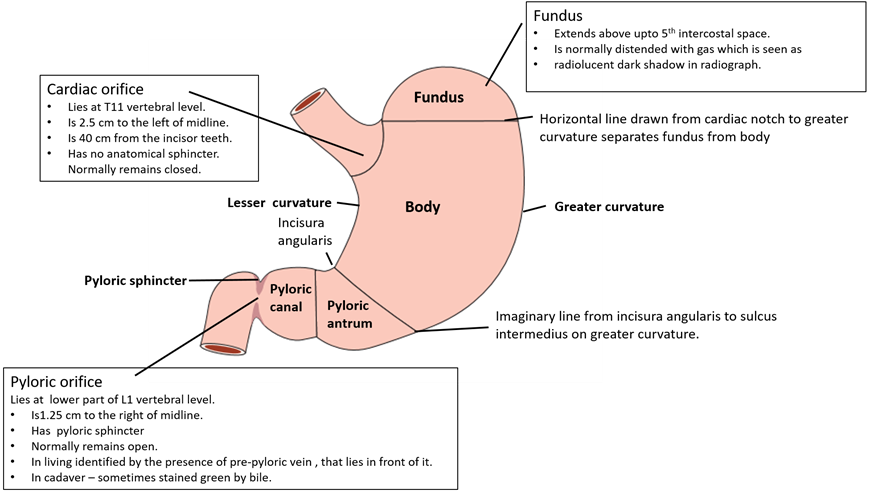
Describe the peritoneal relations of stomach.
The stomach is covered by peritoneum except along lesser and greater curvatures where blood vessels run and a small small area posteriorly near the cardiac orifice. This is known as bare area of the stomach and it is directly related to the left crus of the diaphragm.
The peritoneal folds extending from the lesser and greater curvatures of the stomach to other structures are :
- Lesser omentum extends from the lesser curvature of the stomach to the liver.
- Greater omentum hangs dorn in the abdominal cavity from lower two-third of the greater curvature.
- Gastrosplenic ligament extends from the upper one-third of the greatercurvatureto the hilum of spleen .
- Gastrophrenic ligament extends from the uppermost part of the greater curvature to the diaphragm.
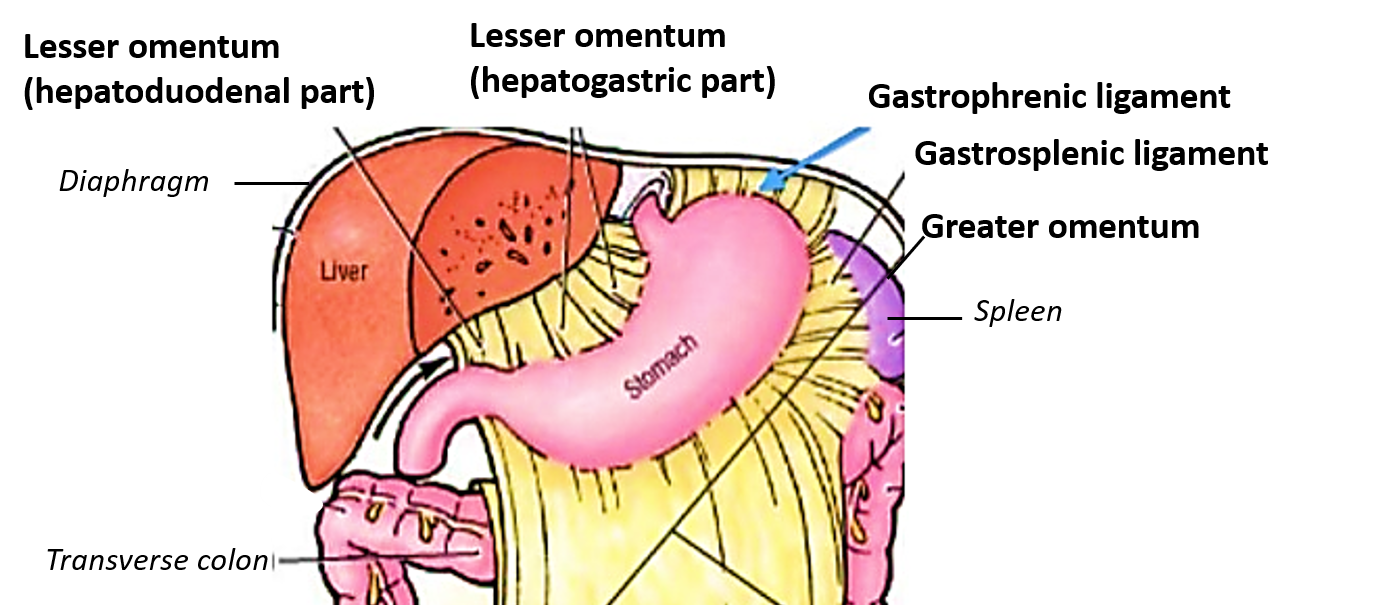
Enumerate the contents of lesser omentum.
- Along the lesser curvature of stomach:
- Left gastric vessels
- Right gastric vessels
- Right and left gastric group of lymph nodes
- Branches of gastric nerves
- In the right free margin of lesser omentum:
- Hepatic artery proper
- Portal vein
- Bile duct
Name the arteries that supply the stomach.
Arterial supply of stomach: Stomach is supplied by branches of celiac trunk.
- Arteries along the lesser curvature are:
- Left gastric (from celiac trunk)
- Right gastric (from hepatic artery, branch of celiac trunk)
- Arteries along the greater curvature:
- Short gastric arteries (from splenic artery, branch of celiac trunk)
- Left gastroepiploic artery (from splenic artery, branch of celiac trunk)
- Right gastroepiploic artery (from gastroduodenal, branch of hepatic which is a branch of celiac trunk)
Arteries form subserosal, intramuscular and submucosal plexus. Long mucosal arteries arise from the submucosal plexus which anastomose and supply mucosa.
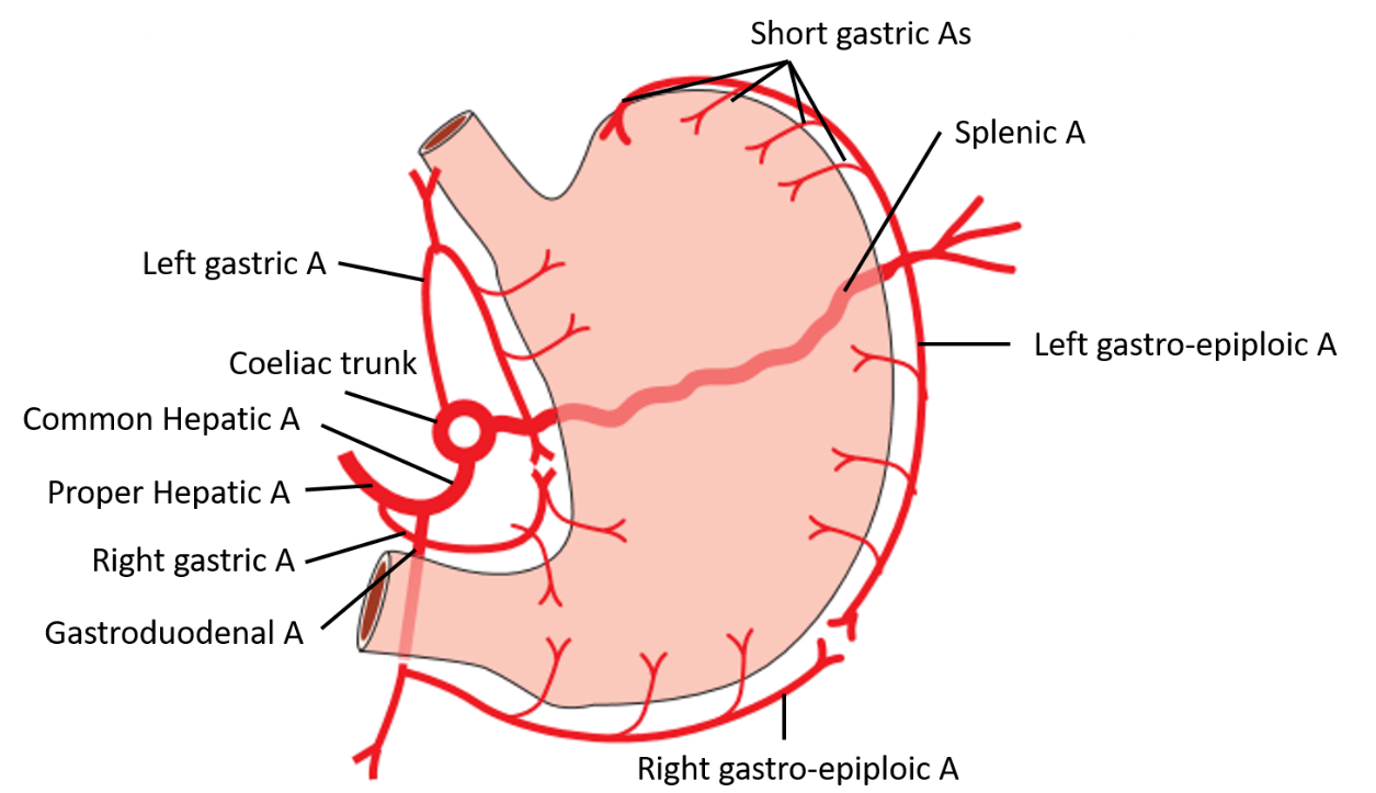
Describe the venous drainage of stomach.
Veins draining stomach accompany the arteries along lesser and greater curvature.
All the veins drain directly or indirectly into portal vein.
- Right and left gastric veins – into portal vein
- Short gastric and left gastroepiploic veins – splenic vein
- Right gastroepiploic vein – superior mesenteric vein
- Pre-pyloric vein – right gastric vein
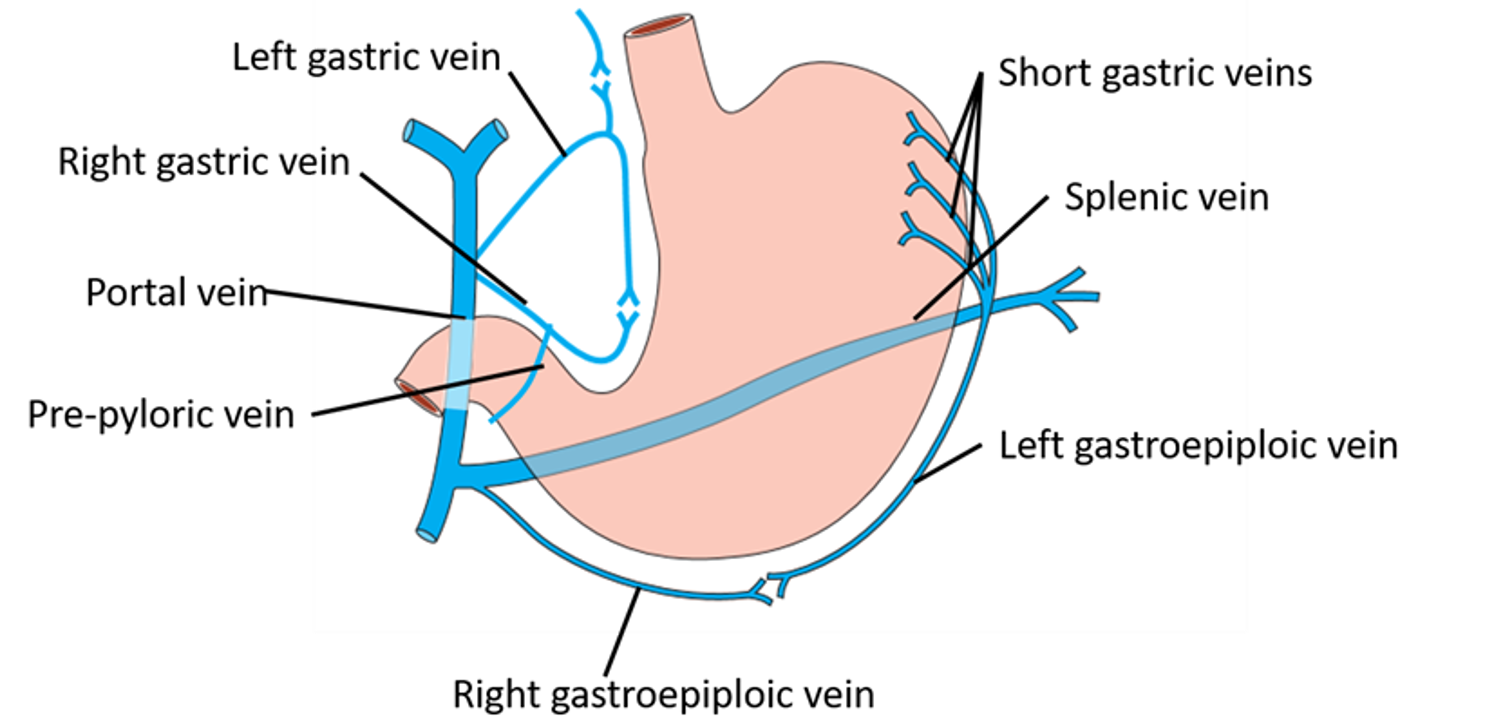
Describe the lymphatic drainage of stomach.
- Lymph vessels accompany the blood vessels of the stomach.
- For describing the lymphatic drainage of different parts of stomach, an imaginary line is drawn that extends from the cardiac notch to the greater curvature and divides the stomach into right 2/3rd and left 1/3rd.
- Right part is further divided into upper 2/3rd and lower 1/3rd.
- Left part is divided onto upper 1/3rd and lower 2/3rd .
- The lymphatics from the above mentioned region drains into the following lymph nodes
- Para cardiac lymph nodes: Cardiac end and the adjoining area.
- Left gastric lymph nodes – Upper 2/3rd of right 1/3rd of stomach.
- Right gastric lymph nodes – Lower 1/3rd of right 1/3rd of stomach.
- Pancreatico-splenic lymph nodes: Upper left 1/3rd of stomach.
- Right gastroepiploic lymph nodes – Lower left 2/3rd of stomach.
- Pyloric and hepatic lymph nodes – Pyloric part of stomach.
- Efferents from all the above lymph nodes terminate into celiac group of pre-aortic nodes. From the coeliac lymph nodes to cysterna chyli and then to thoracic duct.
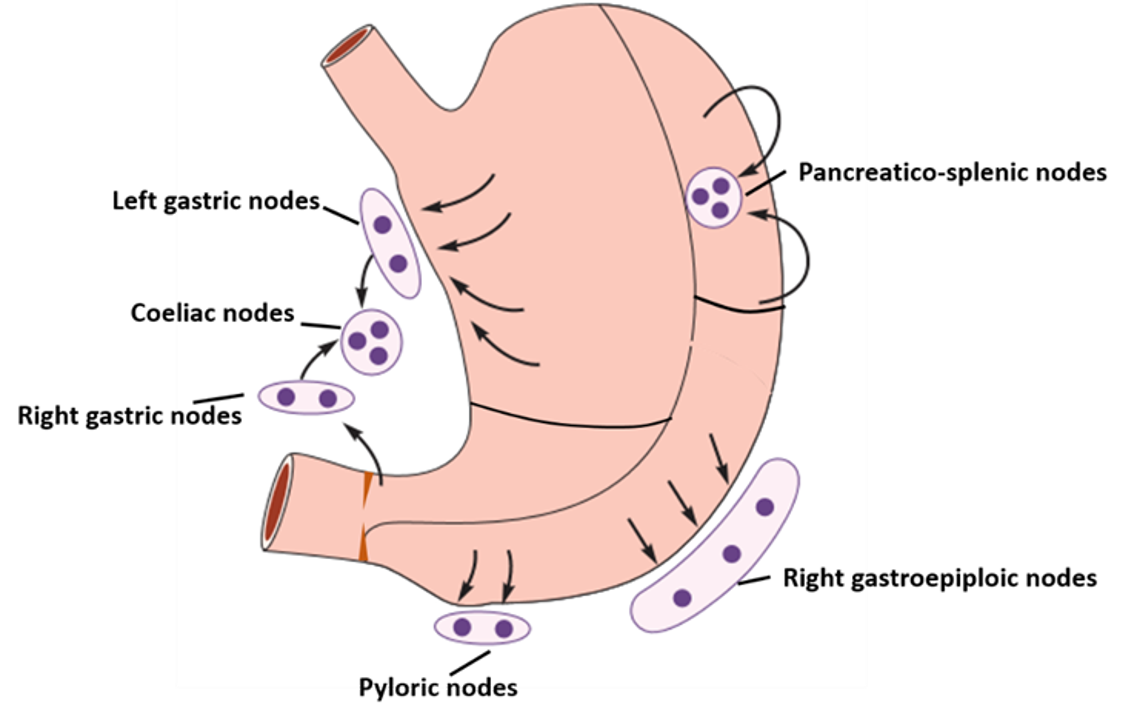
Enumerate the structures forming stomach bed.
- Diaphragm
- Left suprarenal gland
- Left kidney
- Splenic artery
- Pancreas
- Transverse colon
- Splenic flexure of colon
- Spleen
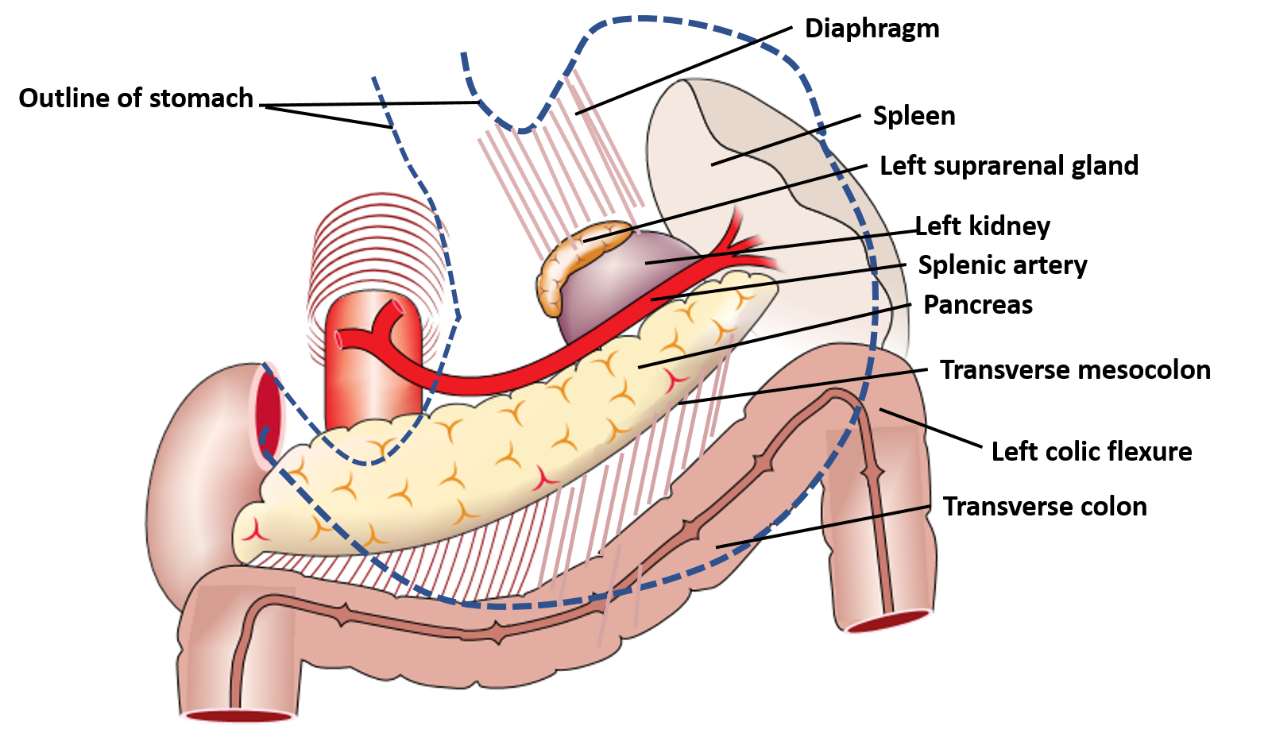
Describe the nerve supply of stomach.
Stomach is innervated by autonomic nervous system.
| Sympathetic | Parasympathetic | |
|---|---|---|
| Preganglionic fibers | Arise from T6-T10 spinal segment ( reach coelic ganglion via greater splanchnic nerves) | Arise from left and right vagus |
| Postganglionic fibers | Arise from coeliac ganglia. | Arise from ganglion in submucosal and myentric plexuses. |
| Action | Vasomotor | Secretomotor |
| Motor to the pyloric sphincter | Inhibitor to pyloric sphincter | |
| Inhibitor to the rest of the musculature | Motor to the musculature | |
| Carry pain sensation | Carry sensation of hunger and nausea |
Applied Aspects
Gastric canal is a common site for occurrence of peptic ulcer
Gastric canal is a common site for occurrence of peptic ulcer because:
- The mucosal folds (rugae) are arranged longitudinally on either side of the lesser curvature to form the canal which allows rapid passage of fluids along the lesser curvature and as a result this area is irritated most by the swallowed liquids.
- Submucosal plexus is absent along the lesser curvature. Mucosal arteries arise from intramuscular plexus. Occlusion of these may produce ischemia and is thought to be one of the reason for frequent occurrence of peptic ulcers along the lesser curvature.
- More number of secretomotor supply from vagal trunks, which run along lesser curvature.
Malignancy from stomach usually spreads to oesophagus but not to duodenum
Malignancy from stomach usually spreads to oesophagus but not to duodenum because at the cardiac end the gastric lymph vessels are connected to the lymphatic vessels of oesophagus, whereas at the pyloric end the lymphatics are not continuous with the lymphatics of duodenum due to the presence of connective tissue septum in the submucosa of pyloric end.
Troiser’s sign
Gastric cancer spreads via lymphatics (thoracic duct) to left supraclavicular lymph nodes. The enlarged left supraclavicular node (Virchow’s node) is known as Troiser’s sign.

Thank you. Didn’t expect a website as helpful as this would even be on the internet.
Imp questions are outstanding 👌🏻💯
I even don’t prefer any book only read from anatomyqa.com 😍
Thanks Vishal.
So helpful.. Thank you
Helped alot
thank you a lot for your amazing work!
Thanks a lot.
Thanks Khush.